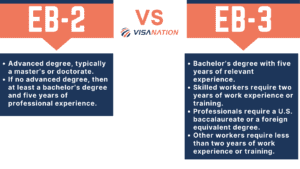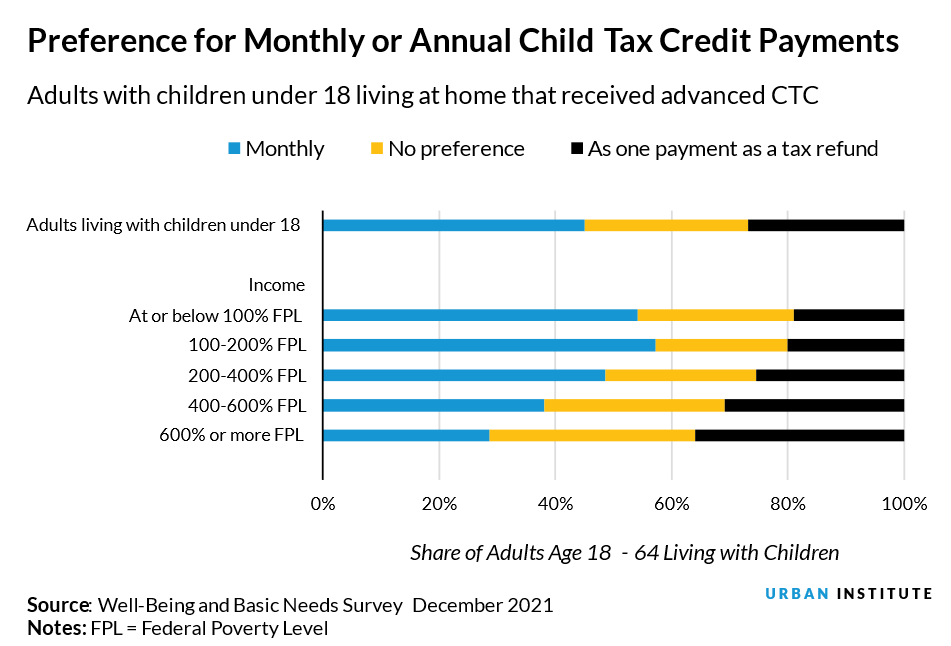EB-2 vs EB-3 Green Card
EB-2 and EB-3 are two types of Employment-Based green card categories. The United States Citizenship and Immigration Services (USCIS) grants these visas to foreign nationals depending on their degrees, professional skills, and country of origin. Before selecting the right one for you, it is best to consider the different options available. On this page, you will learn about the differences between EB-2 vs EB-3, which one is better for you, and more.
Brief Introduction to EB-2 and EB-3
EB-2 or EB-3 green cards entitle professionals and highly-skilled workers to live and work permanently in the U.S. through employment.
The individual preference categories were created by the Immigration Act of 1990, which increased the number of legal immigrants that could enter the US every year from 500,000 to 700,000. Prior to the passage of this act, only 54,000 visas were available yearly to immigrants. Afterward, the number increased to 140,000.
The U.S. seeks to admit residents who can provide economic and societal advantages to the country. As such, future residents must exhibit an “extraordinary ability” or be specially chosen by U.S.-based employers. Individuals with such ability include highly skilled professors, researchers, company managers, and other highly talented people with a valuable skill set.
EB-2 vs EB-3: Key Differences in Employment Classification
The key difference between EB-2 and EB-3 is that the latter has a lot more flexibility. Without a doubt, EB-3 requirements are a lot more lenient than EB-2, which allows more people to qualify for it. There are many potential pathways available to foreigners seeking to enter the US through an employment-based green card. EB-2 and EB-3 are the most popular in terms of number of new applications. It is crucial to know the differences between the two.
EB-2 candidates typically have an advanced (master’s or doctorate) degree. Alternatively, they may be eligible without an advanced degree if they have a bachelor’s degree with more than 5 years of experience working in their domain.
The requirements to get an EB-3 are less stringent. However, they also often require the candidate to have a minimum of a bachelor’s degree and at least 5 years of experience. This category has three different subcategories: EB-3A, EB-3B, and EB-3C.
You may be eligible for one of these immigrant visa preference subcategories if you fall into the category of skilled workers, professionals, or other workers.
- EB-3A: “Skilled workers” are persons whose job requires a minimum of 2 years of training or work experience, not of a temporary or seasonal nature.
- EB-3B: “Professionals” are persons whose job requires at least a U.S. baccalaureate degree or a foreign equivalent and are a member of the professions.
- EB-3C: The “other workers” subcategory is for persons performing unskilled labor requiring less than 2 years of training or experience, not of a temporary or seasonal nature.
In some cases, candidates can obtain EB-2 and EB-3 green cards without these requirements. Nevertheless, applicants should know that they are competing against other applicants that do possess the education and work experiences listed above.
Differences in EB-1, EB-2, EB-3, EB-4, and EB-5 Categories
There are five employment-based categories that grant you permanent residency in the U.S. The category you decide on should depend on your qualifications, studies, and your skills.
The EB-1 green card tends to be the most difficult to obtain yet has the fastest processing time due to the fact that there are fewer steps in the verification process. EB-2 and EB-3 categories require more thorough documentation, longer screenings, and increased wait times. However, more applicants are qualified for EB-2 and EB-3 green cards than any other category listed here.
EB-4 and EB-5 are special cases; the former is reserved for religious workers while the latter is reserved for investors. Each of the five classifications is covered in more detail below.
- EB-1 – Priority Workers. This includes Nobel prize winners, Pulitzer prize winners, Olympians and other award winners. Generally, this is a difficult category to have approved. Since they are held in such high esteem, EB-1 workers do not need a job offer in order to be considered for a visa.
- EB-2 – Professionals with exceptional ability. A formal job offer from an employer is needed to enter the U.S. under this category. EB-2 workers hold advanced degrees and specialized knowledge in fields such as medicine, engineering, energy, leadership, and business.
- EB-3 – Skilled or Professional Workers. EB-3 candidates are those that hold a minimum of a Bachelor’s degree and have at least 5 years of experience. The EB-3 requirements are less stringent but the backlog is much longer as a result. Therefore the processing time for an EB-3 may be several years longer than that of an EB-2.
- EB-4 – Religious Workers. These non-profit workers are usually affiliated with churches, synagogues, mosques, or other religious organizations. While in the U.S., they can only work for these institutions. You may also qualify if you are a:
- Special Immigrant Juvenile
- Broadcaster
- G-4 International Organization or NATO-6 Employee
- International Employee of the U.S. Government Abroad
- Armed Forces Member
- Panama Canal Zone Employee
- Specific kinds of Physicians
- Afghan or Iraqi translator
- Afghan or Iraqi national who has provided faith service in support of U.S. operations.
- EB-5 – Investors. One of the most expensive paths to qualify for, the EB-5 category is reserved for investors that must invest at least $1 million into a U.S. enterprise. Investors need to hire 10 American workers and work in conjunction with the US Department of Labor. If the business succeeds at the end of a 2-year review period, the investor is given a residential visa.
Differences Related To Employer Eligibility
When an EB-2 or EB-3 applicant petitions you, the employer, to sponsor him or her for a green card, there are a few steps you should follow. Keep in mind that you will need to work closely with the USCIS and the United States Department of Labor (DOL) in order to document that you offered a fair hiring chance to all qualified applicants interested in the job.
These are the stages employers should follow when onboarding EB-2 or EB-3 workers:
- Advertise for the job in a newspaper of local circulation for at least 2 Sundays. You may also need to advertise the job position in 3 other recruitment forms. These can include websites, on campus, or job boards.
- Advertise with the State Workforce Agency where the employee will be working. Document the recruitment process. Document all applicants that have applied for the job as well as all efforts to try and reach these individuals. You do not need to interview everyone who sends in a resume, but you do need to make efforts to show you gave all qualified applicants a fair chance.
- File a Labor Certification Application (PERM) with the DOL. Your business will need to show that it has the financial ability to pay the prevailing wage of the applicant and that you are not displacing current workers in the U.S.
- Wait for the visa. Once the PERM has been approved you will need to wait for the EB-2 or EB-3 visa.
Reduce EB-2 and EB-3 Processing Time by Purchasing “Premium Processing”
Once these steps are complete, you may choose to purchase premium processing. This feature reduces the PERM processing time to two weeks for an additional cost of $2,500 which must be paid out to immigration authorities.
In some cases, premium processing may be worth the investment in order to cut wait times. However, keep in mind that applicants will still need to wait in queue for their EB-2 or EB-3 green cards.
EB-2 and EB-3 Priority Dates
Your priority date is the date in which the USCIS receives your I-140 petition. Because there is a limit to how many immigrant visas are provided each year, some visa preference levels have developed a significant backlog.
Each month, the Department of State (DOS) releases a Visa Bulletin that is designed to inform applicants what the current final action dates are. When the final action date matches your priority date, a visa number will become available for you and you can file your I-485. The posted final action dates vary according to your country of origin.
The Visa Bulletin provides the most recent date for when a visa number is available for the different categories and countries for family-sponsored, employment-based and diversity (lottery) visas and categories.
EB-3 to EB-2 Porting
Due to the drastically reduced wait time concerning priority dates, many applicants attempt to transfer their EB-3 petition to the EB-2 category.
This, however, will require you to obtain a new position with the same or different employer that is substantially more complex than your original job. It also may require an advanced degree or five years of experience on top of your bachelor’s degree.
If you are able to secure such a position, then you can have your employer file for another PERM Labor Certification for your new position. Once that has been done, your employer can then file a new I-140 petition and request to have the old priority date retained.
Because this process can easily be complicated and delicate, it is important to retain the services of a qualified immigration attorney to help make sure that the process goes as smoothly as possible.
Final Tips
You should review the process carefully in order to determine the most appropriate option. An honest assessment of your schooling, skills, and years of relevant industry experience will help decide which category is best for you.
Find out the minimum requirements for employers and employees by working with a qualified immigration attorney. That way, you’ll be able to showcase yourself in the best light when you are being considered for a green card.
How VisaNation Immigration Lawyers Can Help
VisaNation Law Group immigration attorneys have unique experience in employment-based cases. They can help you select the right green card category based on your qualifications and help you gather the supplementary documentation to determine whether you meet the required specifications.
Let us aid you and your family members in developing an optimal strategy to highlight your specific skills and accomplishments. Contact us today for a free consultation.






